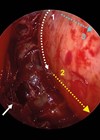How I Do It
Transnasal endoscopic orbital decompression
Surgery for the eye complications of Grave’s disease is an area that, over the years, ENT has become more and more involved in due to our ability to access the orbit endoscopically. In this article, the authors describe their technique...
Face shield modification in ENT during COVID-19 pandemic
The COVID pandemic has caused a huge disruption to our lives, not least at work where safety restrictions and the widespread implementation of PPE have led to some challenges to carrying out routine ENT work. In this article, the authors...
Foreign object removal from the ear or nose
The range of nasal and aural foreign bodies that present to accident and emergency (A&E) departments, emergency rooms and minor injury units is limited only by the imagination. Aetiology and epidemiology statistics point to patients being predominantly children in the...








